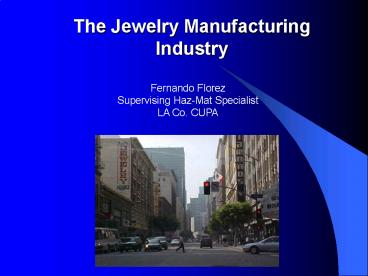The Jewelry Manufacturing Industry - PowerPoint PPT Presentation
1 / 28
Title:
The Jewelry Manufacturing Industry
Description:
The Jewelry Manufacturing Industry Fernando Florez Supervising Haz-Mat Specialist LA Co. CUPA Introduction Jewelry Industry Overview Jewelry Manufacturing Process ... – PowerPoint PPT presentation
Number of Views:1862
Avg rating:3.0/5.0
Title: The Jewelry Manufacturing Industry
1
The Jewelry Manufacturing Industry
Fernando Florez Supervising Haz-Mat
Specialist LA Co. CUPA
2
Introduction
- Jewelry Industry Overview
- Jewelry Manufacturing Process
- Jewelry Sampling Project / Hazardous Waste
Concerns
3
Industry Overview
- The LA Jewelry Mart District is the second
largest manufacturing market in the U.S. - There are 30 buildings currently used by
approximately 400 jewelry manufacturing and
repair businesses. - Six buildings have been converted to full
manufacturing.
4
Industry Overview
- The District is comprised of a complete jewelry
network support system - Precious stone sales.
- Precious stone setters.
- Jewelry sales.
- Jewelry repair.
- Jewelry manufacturing.
- Jewelry manufacturing equipment sales.
- Many of the businesses in the LA Jewelry District
are family owned, with less than 5 employees.
5
Jewelry ManufacturingProcess
- There are 9 process steps to manufacture jewelry.
- Various raw materials and hazardous materials are
utilized in the process. - Various hazardous wastes are generated.
6
Jewelry ManufacturingProcess
Step 1 - Jeweler conceptualizes and creates a
master original piece.
7
Jewelry ManufacturingProcess
Step 2 - Preparation of Rubber Mold.
Original piece is placed between 6 molding rubber
pieces secured in molding frame.
Mold is placed in Vulcanizer unit at 325 F for 35
min.
Mold is cut opened and original piece is removed.
3- D space is cut out.
8
Jewelry ManufacturingProcess
Step 3 - Preparation of Wax Piece.
Wax injected into empty mold at 180 F
Wax piece is removed from rubber mold and
attached to a sprue.
Several wax pieces can be attached for mass
production.
9
Jewelry ManufacturingProcess
Step 4 - Preparation of Investment Mold
Wax Sprue is placed into a stainless steel
cylinder.
Investment Plaster is poured and set to dry for
10 min.
Cylinder cured in Kiln 1500 F for 4 hours. Wax
melts thus leaving a 3-D space inside cast.
10
Jewelry ManufacturingProcess
Step 5 - Casting by Centrifuge OR Vacuum.
Cylinder is placed in Centrifuge unit. Gold
pellets are melted at 1600 F in crucible with
torch.
Cylinder is place in Vacuum unit. Gold pellets
are melted and poured cylinder.
11
Jewelry ManufacturingProcess
Step 6 - Devestment.
Cast cylinder is washed to remove the jewelry
sprue from the plaster.
Sprue Tree is ready for individual piece removal.
12
Jewelry ManufacturingProcess
Step 7 - Jewelry Pieces are Cut From Sprue Tree
and Soldered, Grind and Polished.
13
Jewelry ManufacturingProcess
Step 8 - Cleaning and Removal of Oxides, Fire
Scale and Flux Residue with Haz-Mats.
Cyanide Bombing - Jewelry with deep recesses is
cleaned in a solution of 10 liquid potassium
cyanide and 35 hydrogen peroxide.
Pickling Cleaning - Jewelry with minor recesses
is cleaned in a solution of 10 Hydrochloric Acid.
Electrocleaning - Jewelry is cleaned in a Pyrex
glass using a solution of NaCO4, NaOH, KCn with a
6V charge.
14
Jewelry ManufacturingProcess
Step 8 - Alternative Cleaning without Haz-Mats.
Magnetic Tumblers - Electrical units with metal
shot and magnets. The metal shots vibrate and
spin and cleans the jewelry.
Ultrasonic Units - Electrical unit with soap and
water mixture. Electricity is converted to sound
waves and the bubbles created, cleans the jewelry.
15
Jewelry ManufacturingProcess
Step 9 - Polishing.
Electrical unit with a felt wheel or lap wheel,
which removes emery marks. Tripoli and Rouge
add lustrous shines
16
Jewelry ManufacturingProcess
Deep Recess Jewelry
17
Sampling Survey Project
- In 2003, DTSC, UCI, and LACo CUPA conducted
haz-waste sampling of jewelry manufacturing
buildings. - Swab samples were collected from walls and
equipment. - Solid samples were collected from polishing
dusts, sludges, and investment materials. - Liquid samples were collected from cleaning and
pickling solutions.
18
Sampling results from Buffing, Polishing, and
Grinding Dusts
- The following metals exceeded regulatory levels
for hazardous wastes - Copper
- Nickel
- Zinc
- Silver
- Arsenic
- Cadmium
- Selenium
- Barium.
19
Sampling results from Investment Wastes
- Copper and nickel exceeded the regulatory metals
for hazardous waste, but not consistently. - Therefore, investment wastes are not confidently
classified as hazardous
20
Sampling results from Pickling Solutions
- Copper, Cadmium, Nickel, Zinc, Chromium and lead
was consistently detected above the hazardous
waste levels
21
Sampling results from Ultrasonic Cleaning
- Elevated Copper, Chromium, Lead, and Silver
levels confirmed that spent solutions from
ultrasonic cleaning is a hazardous waste.
22
Sampling results from Acid Cleaning
- Elevated Cadmium, Chromium, Copper, Nickel, Lead,
and Zinc exceeded hazardous waste regulatory
levels. - The pH of 2 deems the spent acid cleaner to be a
hazardous waste.
23
Sampling results from Cyanide Bombing
- 97 of the cyanide is consumed in the process of
removing fire scale. - Elevated copper deems the waste solution to be
hazardous waste.
24
Sampling results from Influent Wastes to basement
Treatment Units
- The following hazardous waste characteristics
were tested pH, metals, and cyanide. - The waste was not deemed to be hazardous because
the waste was commingled and diluted.
25
Sampling results from Sludge captured at the
Treatment Unit
- Copper and Nickel exceeded the hazardous waste
regulatory levels.
26
(No Transcript)
27
Conclusions
- Hazardous waste is produced by polishing,
cleaning, stripping or cyanide bombing. - Manifests required for spent stripping and
cyanide bombing solutions. - The solid waste streams meet the definition of a
Excluded Recyclable Material, because of the
high value of Gold, which is refined and
recycled. - Bill of lading / Refining receipts required for
polishing dust, floor sweeps, and also solid
waste of tumbling and ultra sonic cleaners.
28
Jewelry Manufacturing
- Questions / Comments































